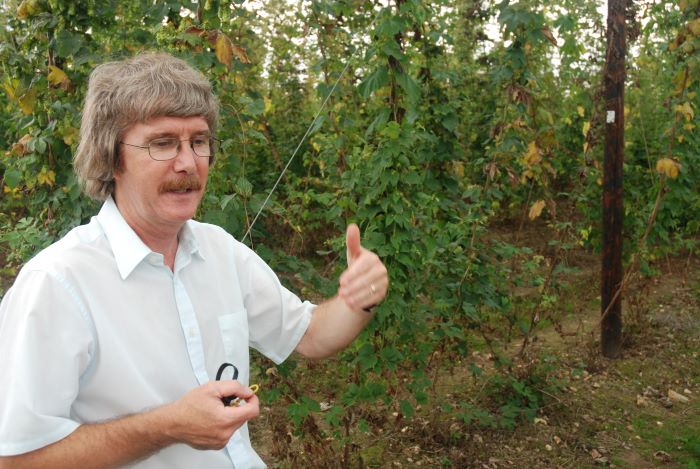From Vol. 3, No. 9, February 2019

Peter Darby, who has been breeding hops in England for almost 40 years, once said this: “English flavor is like a chamber orchestra, the hops giving simultaneously the high notes and the bass notes. In comparison, a Czech beer is more like a full orchestra with much more breadth to the sound, and an American hop gives more of a dance band with more emphasis on volume and brass. The recent New Zealand hops (e.g. Nelson Sauvin) are like adding a voice to the instrumental music.”
That should get your attention. Darby took over the breeding program at Wye College in 1981. Wye is where E.S. Salmon began cross breeding hop varieties more than 100 years ago, the result changing hops in ways he may never have imagined. There’s more of that history in For The Love of Hops, and a mini-version in a story posted last week at Good Beer Hunting.
In 2007 Britain’s government yanked funding for the program at Wye, which since 1948 had been an equal partnership between industry and the government. “We would have lost 100 years of experience,” said hop farmer Tony Redsell, who spearheaded the establishment of Wye Hops Limited, with Darby at the helm. Darby retires from what he calls “the day job” in March. He will still do some consulting.
He delivered the keynote address at the American Society of Brewing Chemists convention last summer, so it seemed appropriate to ask him via email what seems different about the way brewers, and brewing scientists, view hops now as opposed to 20 years ago. He wrote back:
“There has never been more interest in hops during my career than there is now. The obvious difference between the view of hops now and 20 years ago is that flavour is now all important and impact flavour is more important than traditional aromas. As this is a very subjective area, it means that everyone in the field can have an opinion and no-one is right or wrong.
“There is no unifying definable scientific goal at present and so breeding and use of hops is being undertaken by almost anyone; growers, merchants, hobbyists, scientists etc. Previously, it was left to those with appropriate scientific credentials or brewing experience. But now we do not have sufficient science to explain flavour and so hops have passed back into the art of brewing rather than the science.
“Clearly, increased alpha is no longer the main goal and, with dry hopping in quantity, some of the minor bittering compounds such as humulinones are now getting attention. It seems to me that there is a lot of brewing science and breeding science going on, but it is in the background whilst the attention is taken by the taste panels and social media posts.
“Although pest and disease resistance and yield increase remain important goals, there are still sufficient pesticides that the existing threats are all under control. Perhaps climate change will provide the catalyst for the next change in direction for the hop industry.”
Darby has been generous about keeping me on the right track since I first began researching “For The Love of Hops” (the photo at the top was taken when I visited him in 2011). We’ve exchanged emails about the heritage of multiple varieties, because sometimes there is conflicting information. I asked, he answered:
“I do not want to single out particular websites. I will just give a couple examples in general. Most of the inaccuracy that I come across is in pedigree information. The first example is the pedigree of Admiral. It is actually the result of a cross between two numbered selections. So, the BHA quote it correctly as being of Northdown and Challenger breeding lines.
“In fact, Challenger is its maternal grandmother and Northdown is its paternal great grand-aunt. Its pedigree is mentioned in at least three other websites other than the British Hops (BHA) website. These others incorrectly state that it is a cross between Northdown and Challenger, or that it is a seedling of Northdown. This type of simplification to give inaccurate information is typical.
“The second example involves the pedigree of the new dwarf varieties in the Czech Republic. These have arisen from pollen provided to the Hop Research Institute from the collection here at Wye Hops as part of a European project. I know the pedigree but (those at) the Czech Institute do not. So, the several websites which mention these varieties give various incorrect pointers mentioning other dwarf varieties including First Gold, Sovereign or Minstrel as the origin.
“One even says that they are the result of a cross between First Gold and Sovereign which, as two female varieties, is completely wrong. In fact, there is no First Gold in their pedigree at all and it is unlikely that any of the other named varieties are in their direct pedigree.”
There is never going to be a hop breeding question on Jeopardy. (The answer is Mistral. Your question would be, “What is the daughter of a cross between Cascade and a brother of Barbe Rouge.”) But getting these things right still matters. New technology is arming breeders with important knowledge, but it doesn’t make basic (and correct) information less valuable.
I hope your eyes did not glaze over during all of this. Just in case, I’ll repeat an important insight from Darby: “Hops have passed back into the art of brewing rather than the science.”